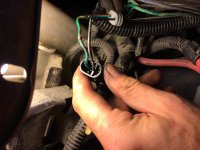liquidXJ
New member
Hey, new to this forum and I'm in need of some help with my 96 XJ 4.0 five speed. I bought it strictly for a work vehicle and maybe some fun when it's not being used for that. Anyways.... Ran and drove just fine for about a month or so. What I know about it... Engine has been rebuilt, 2" suspension lift, borla exhaust (no cat), aftermarket stereo, aftermarket temp gauge, additional fan for the radiator nothing serious. It was throwing a CEL so I went and got the codes ran, front O2 sensor. Since I ordered it online it took a little bit to come in, during this time I had the power steering looked at by a local shop because it was whining a bit. Found that one of the lines was routed too close to the fan and it was just a matter of time before it ate through it completely. Had the lines replaced and re-routed. Got it back no problems, no whining. While on the way back from work one day it started sputtering and actually stalled out on me pretty close to my house. Gas gauge read nothing and the light came on. figured it just got low on gas. Ran back to my house and put about 3 gallons in it. Still wouldn't start. Tow strapped it back to my house with my truck and figured it had something to do with the O2 sensor.
Next day I replaced the O2 sensor and it fired right up in the driveway. Ran for a good 2-3 minutes and then died. All this time the gas gauge light was still on and I'm thinking maybe its still low on gas but I couldn't get started again to get it to the gas station to fill the tank. After doing some research all my indicators pointed to the crankshaft position sensor. Went and picked up the sensor. When I pulled the old one out it looked like it was brand new and had just been replaced but I put the new one in anyways. Still cranking but won't turn over and the gas gauge light is still on. I pulled the door buzzer to see if I can hear the fuel pump energizing. Nothing. Replaced the fuel pump, strainer, filter and all the lines/clamps associated with that area. Nothing, still cranking won't turn over. Also I still can't hear the pump kick on. I've read some things about the ECM and it shorting out. I'm open to try anything at this point but not really sure where to start seeing as how it was running and driving less than a week ago. I've swapped around relays with no change in the problem as well.
Any and all ideas are welcome seeing as how I'm somewhat new to the jeep world.
Next day I replaced the O2 sensor and it fired right up in the driveway. Ran for a good 2-3 minutes and then died. All this time the gas gauge light was still on and I'm thinking maybe its still low on gas but I couldn't get started again to get it to the gas station to fill the tank. After doing some research all my indicators pointed to the crankshaft position sensor. Went and picked up the sensor. When I pulled the old one out it looked like it was brand new and had just been replaced but I put the new one in anyways. Still cranking but won't turn over and the gas gauge light is still on. I pulled the door buzzer to see if I can hear the fuel pump energizing. Nothing. Replaced the fuel pump, strainer, filter and all the lines/clamps associated with that area. Nothing, still cranking won't turn over. Also I still can't hear the pump kick on. I've read some things about the ECM and it shorting out. I'm open to try anything at this point but not really sure where to start seeing as how it was running and driving less than a week ago. I've swapped around relays with no change in the problem as well.
Any and all ideas are welcome seeing as how I'm somewhat new to the jeep world.
Last edited by a moderator:



